As 2024 unfolds, the digital marketing landscape undergoes a revolutionary shift propelled by emerging trends from the previous year. Key drivers such as personalization, artificial intelligence, and immersive technologies like augmented reality and virtual reality (AR/VR) have taken centre stage, significantly elevating user engagement and expanding the possibilities for marketers. These advancements are poised to exert a transformative influence on strategies and industry standards for the foreseeable future.
In 2023, the global digital advertising market reached a valuation of $601.8 billion, with media ads constituting 67.1% of the total expenditure. The substantial growth underscores the lucrative nature of the digital advertising industry, prompting an increasing number of companies to seek ways to capitalize on this flourishing trend.
Here are 20 digital advertising trends that are likely to shape marketing strategies in 2024, categorized across various domains:
- Video Advertising Trends
- Social Media Advertising Trends
- eCommerce Advertising Trends
- Audio Digital Marketing Trends
- Content-Centric Trends in Advertising
- Mobile Advertising Trends
- Personalization Trends in Advertising
- Video Advertising Trends
The proliferation of mobile devices has fundamentally altered how individuals connect and engage in business, in an era where the success of marketing campaigns hinges on video advertisements. The following trends within video advertising present new opportunities for businesses to effectively reach their target audience.
1. Shorter Video Ads
Consumers today exhibit limited patience for lengthy video ads, with over 25% admitting they would cease watching within the first 10 seconds. More than half indicated they would discontinue viewing after 20 seconds. This has led advertisers to embrace bite-sized video ads, especially when presented sequentially. To optimize engagement, it is recommended that Instagram videos should not exceed 30 seconds, Twitter videos limited to 45 seconds, and Meta (formerly Facebook) videos kept within a one-minute duration.
According to a study conducted by HubSpot, short-form video has emerged as the favoured format for product discovery, particularly among Gen Z (57%) and Millennials (42%). Recognizing its potency, a significant 54% of social media marketers have selected short-form video as their primary format. Notably, 33% of marketers express their intention to allocate more resources to short-form videos than any other format in their upcoming strategies.

Source: Hubspot
The efficacy of short-form video is resoundingly clear, with a compelling 83% of users deeming it the most effective format. Among those already investing in short video ads, a substantial 90% have plans to either maintain or increase their investment in this format.
In a noteworthy trend, 42% of marketers who have not yet explored short-form videos express their intention to give it a try, solidifying its position as the preferred format for today’s modern marketers.
2. Sustained Popularity Expected for Shoppable Video Ads in 2024
Shoppable advertisements, aptly named for their functionality allowing customers to directly browse and purchase products within the ad, are poised to maintain their popularity in 2024.
The future of advertising appears to be centred around shoppable media, with a significant 57% of global ad agency professionals foreseeing it as the upcoming frontier in marketing.
Demonstrating their effectiveness in cutting through the noise and enhancing customer engagement, shoppable TV ads have proven to be a standout feature. According to a survey by Samsung Ads, more than half (55%) of smart TV viewers recall encountering a shoppable ad, and an impressive 50% actively engaged with one.
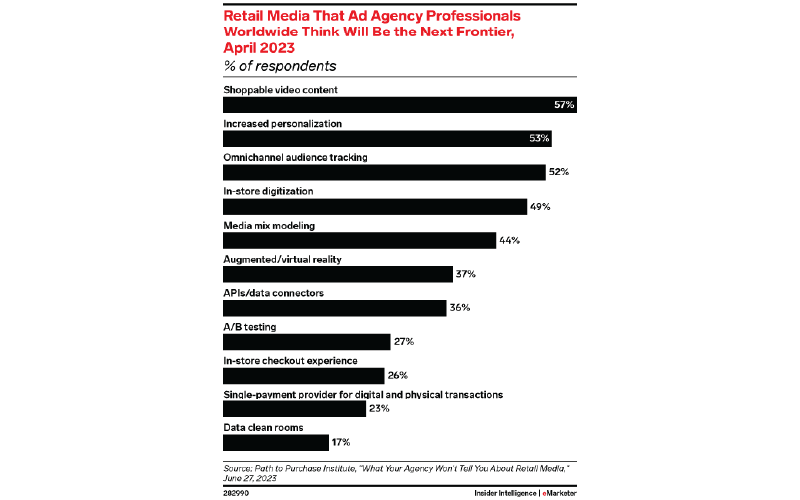
Source: Insider Intelligence
Walmart’s experience underscores the impact of shoppable ads, with campaigns utilizing Roku’s shoppable ads boasting click-through rates (CTR) at least three times higher than average video campaigns run through its digital signal processing (DSP).
Several companies have witnessed positive outcomes by integrating shoppable ads into their digital campaigns. The Fresh Market, for example, strategically employed on-site shoppable videos to enhance its customer engagement strategy, aiming to recreate the enjoyable in-store shopping experience on its digital platforms. The addition of short shoppable videos on its website resulted in a significant uptick in engagement rates for videos (113%) and session time (115%).
Similarly, Stolen Stores adopted shoppable videos across their website, utilizing various formats to captivate visitors and drive conversion rates through one-click purchasing. This approach yielded a notable 10% increase in the average order value.
3. Making Noise About Out-Stream Video Ads
We’ve all been there browsing a webpage when an unexpected video ad suddenly blasts at full volume, an experience that leaves many frustrated. In fact, a resounding 66% of individuals express their disdain for video ads that automatically play with sound.
Revealing the Silent Preference for Video Ads
Surprisingly, a significant 53-78% of people express a preference for having the sound turned off when encountering video ads, a preference that varies depending on the context.
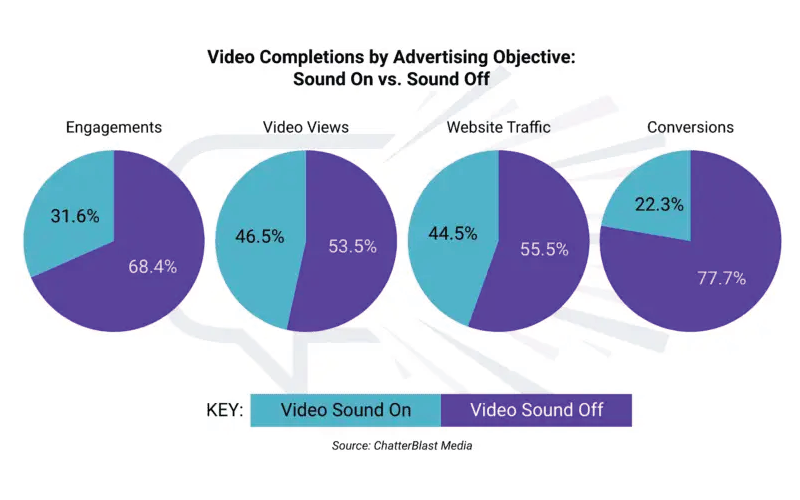
Source: ChatterBlast Media
Here are additional advertising statistics underscoring the ascendancy of sound-off video ad formats over autoplay ads:
A substantial 85% of Facebook users opt to watch videos without sound
On LinkedIn, an impressive 79% of videos are viewed in silent mode.
Videos incorporating captions experience a noteworthy 12% increase in viewing time
The remedy to this evolving consumer behaviour comes in the form of out-stream video ads. These ads seamlessly integrate within the content users are perusing, automatically playing without sound upon scrolling over and pausing when out of sight.
Statistical insights further highlight the effectiveness of out-stream ads, demonstrating higher click-through rates (CTR) and prolonged engagement compared to in-stream video advertising.
In response to these trends, marketers are increasingly turning to captions. Research indicates that the presence of captions enhances viewer retention, with 80% of consumers more likely to complete watching a video when captions are available.
4. Social Media Advertising Trends
Social media serves as a platform for businesses to establish interactive and personalized connections with customers. The previous year witnessed the influence of the following trends in shaping the landscape of social media advertising.
Authenticity Tops the List of Consumer Demands in Social Media Ads
The significance of authenticity cannot be overstated, with 88% of consumers making it a priority when selecting brands to support.
Rare Beauty, the brand associated with singer-actress Selena Gomez, exemplifies authenticity in marketing. Rather than partnering with celebrities or high-profile influencers, the brand opted for collaborations with relatable creators who genuinely use its cosmetics. This approach resulted in an impressive 98% of total campaign conversions driven by creator content on TikTok.
Humanizing brands is also a focal point for advertisers through influencer marketing. Lenox, a classic dinnerware company, employed influencers to reshape the perception of its products among young consumers.
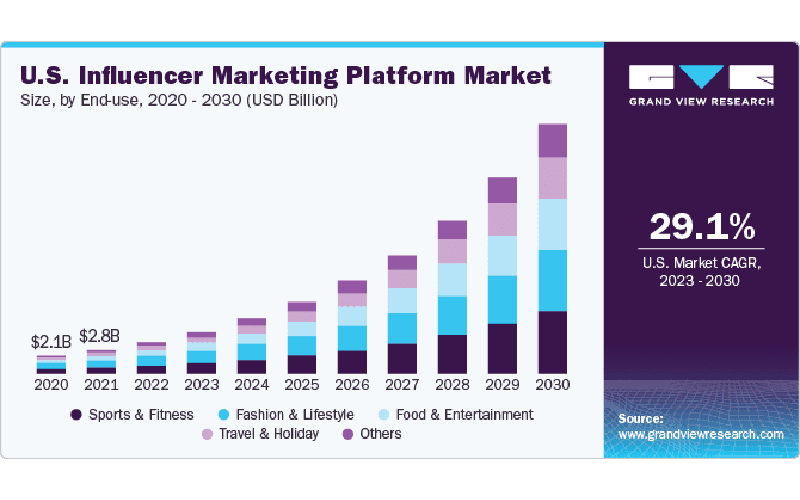
Source: Grand View Research
In a strategic move, the company joined forces with 32 influencers who showcased Lenox’s dishes in unique and non-traditional home settings. The campaign exceeded expectations, generating close to 900 link clicks, surpassing the estimated potential reach by nearly 400%.
The global influencer marketing size witnessed significant growth, more than doubling since 2019 and reaching an estimated $21.1 billion in 2023.
Data sourced from Grand View Research indicates a projected 33% compound annual growth rate (CAGR) from 2023 to 2030, driven by the preference for online influencers over traditional celebrities for product endorsements.
5. Micro-Influencers Gaining Preference Over Celebrities in Influencer Marketing
In the realm of influencer marketing, there’s a notable shift towards favouring micro-influencers over celebrities. According to HubSpot, a substantial 80% of influencer marketers opt to collaborate with small creators, defined as those with follower or subscriber counts ranging from 1,000 to 99,999, while only 16% engage with accounts boasting over 1 million followers.
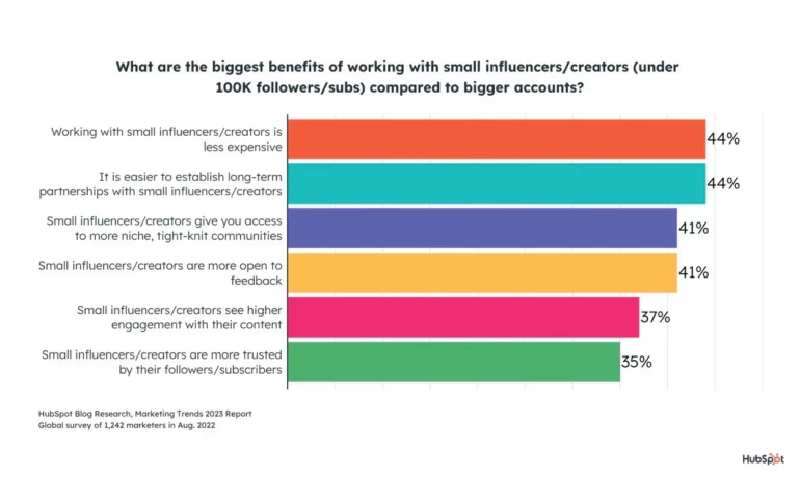
Source: Hubspot
The appeal of micro-influencers lies in their cost-effectiveness, as highlighted by 44% of marketers. 56% of influencer marketers actively choose to partner with micro-influencers. This shift reflects a transformation in influencer marketing, moving beyond a focus solely on follower count to prioritize content quality and alignment with brand values.
In the digital landscape, particularly among Gen Z, a significant portion of social media users prefer discovering products through influencers, solidifying the enduring relevance of influencer marketing. However, advertisers are now tasked with the crucial responsibility of discerning which influencers provide the most value.
eCommerce Advertising Trends
With a staggering 24 million eCommerce stores globally, the competition for businesses has reached unprecedented levels. To successfully stand out and attract customers, staying abreast of the latest eCommerce advertising trends is paramount.
6. Amazon Dominates eCommerce Advertising
In the realm of e-commerce advertising, Amazon has established itself as the undisputed leader, commanding over 75% of the total e-commerce ad spending.
The eCommerce giant’s remarkable ad revenue surpasses $7 billion, securing a considerable lead over Walmart, which follows with just over $1.5 billion in ad revenue. An estimated 60% of consumers designate Amazon as their favourite online store.

Source: Statista
Amazon’s advertising revenue continues to surge, propelled by its cost-effectiveness and impressive return on investment (ROI) in comparison to search engine optimization (SEO) or search engine ads. With an average cost-per-click of $0.71 and an outstanding conversion rate of 9.58%, Amazon outperforms U.S. eCommerce sites, which typically see only a 2.57% conversion rate.
This attractiveness has positioned Amazon advertising as a compelling choice for numerous eCommerce businesses. In 2023, sponsored products constituted a significant 78% of global ad spending on Amazon.
Notably, Amazon is expanding its Sponsored Products ads to include premium apps and websites such as Pinterest, BuzzFeed, Hearst Newspapers, and Raptive.
Sponsored product ads are strategically placed at the top and bottom of the page, recognizing the significance of placement. A noteworthy statistic reveals that 35% of Amazon shoppers click on the first product, and the top three products collectively receive 64% of all clicks.
7. More Brands Will Experiment With Native Ads
In 2023, more marketers were expected to leverage native ads, with almost a quarter (23%) planning to do so for the first time
Why the increasing interest in this strategy? Simple it works!
The same study found that over 36% of marketers using native ads find them effective, with nearly 50% ranking them as their top tactic for generating ROI.
Unlike traditional advertising, native ads seamlessly promote your brand to a new audience without interrupting their experience.
Top jewelry manufacturer, Pandora, was struggling to reach new, high-quality audiences at scale to build its brand in France. After adopting native ads, the company saw a 130% increased conversion rate.
And, as it turns out – consumers tend to view native ads 53% more frequently than banner ads
Audio Digital Marketing Trends
A less explored but rapidly growing area of digital marketing is audio advertising. With the popularity of podcasts, music streaming services and smart speakers, businesses are now looking to incorporate audio ads into their marketing strategies.
8. The Surge of Audio Advertising
Audio advertising, a method of promoting products or services by incorporating ads into digital audio content, is experiencing a notable rise. These ads are commonly featured on digital radio shows, podcasts, or music streaming platforms. According to Insider Intelligence, U.S. adults dedicated more daily time to listening to digital audio (1:40) than engaging with subscription video services (1:27) or using social media networks (1:15) in 2022.
The appeal of audio ads lies in their cost-effectiveness, ease of personalization, and adaptability for insertion into various audio media such as podcasts and audiobooks.
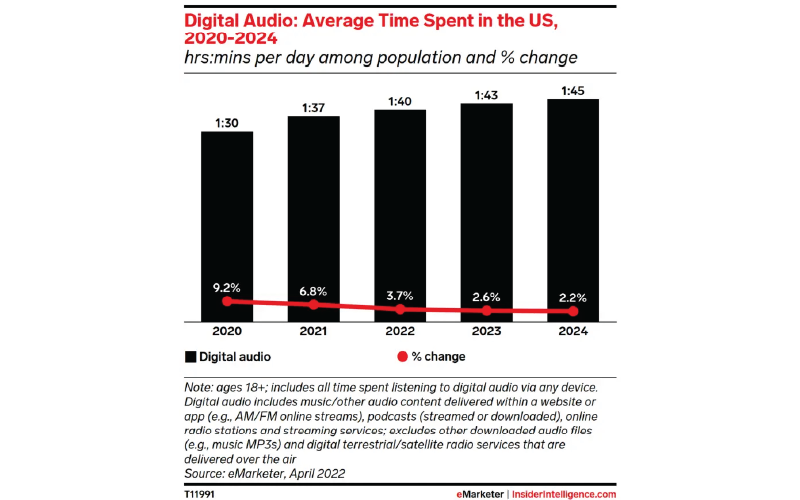
Source: Insider Intelligence
Podcast advertising, in particular, has witnessed a surge in popularity. Statista reports that over 82 million Americans listened to podcasts in 2021, predominantly among millennials and Gen Zs.
The global podcasting market saw substantial growth, increasing from $20.14 billion in 2022 to $25.85 billion in 2023 at a compound annual growth rate (CAGR) of 28.4%. Projections indicate a further ascent to $66.24 billion by 2027 at a 26.5% CAGR.
Moreover, Edison Research discovered that 51% of surveyed consumers pay more attention to podcast ads than other forms of media, reinforcing the significance of considering investments in this medium.
9. Anticipated Rise in Voice Search Optimization for Advertisements in 2024
In 2023, a HubSpot study foresaw that approximately 28% of marketers would cease their efforts in voice search optimization. However, the landscape is poised for a shift in 2024 as the usage of voice assistants is expected to surge.
According to Statista’s research, the number of digital voice assistant users is projected to reach 8.4 billion by 2024, a significant increase from 4.2 billion in 2020. While these assistants are commonly employed for routine tasks such as setting alarms or playing music, their use extends to information retrieval as well.
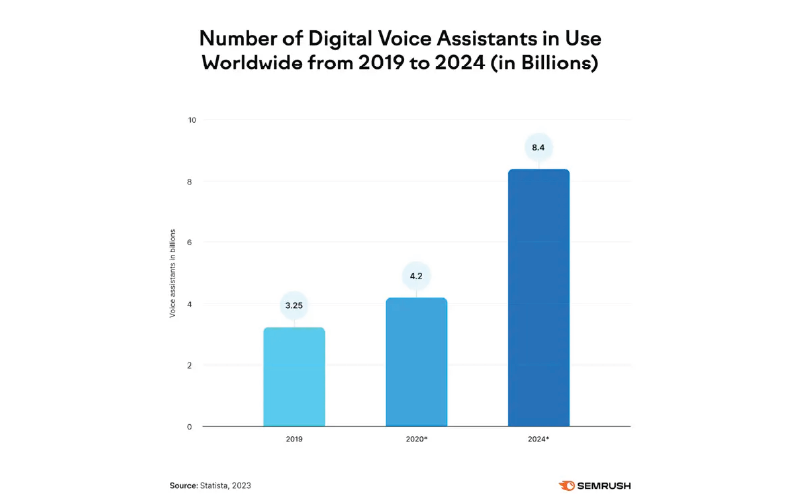
Source: Semrush
This surge in voice assistant usage highlights the potential prevalence of ad optimization for voice search in the coming year, as marketers seek to tap into the expanding user base and evolving digital behaviors.
Content-Centric Trends in Advertising
From user-generated content to fostering authentic influencer collaborations, content-centric advertising is a strategy that lends a distinctive voice and personality to your brand. These trends are centred around establishing meaningful connections with your audience through the creation of high-quality, relevant content.
10. User-Generated Content Maintains Its Dominance
User-generated content (UGC), encompassing text, images, videos, or audio created by end-users rather than brand creators, remains a cornerstone trusted by 86% of brands and retailers. The compelling advertising statistics below shed light on its enduring effectiveness:
62% of consumers express a preference for customer photos over brand-created images when interacting with content like ads, websites, social posts, or emails.
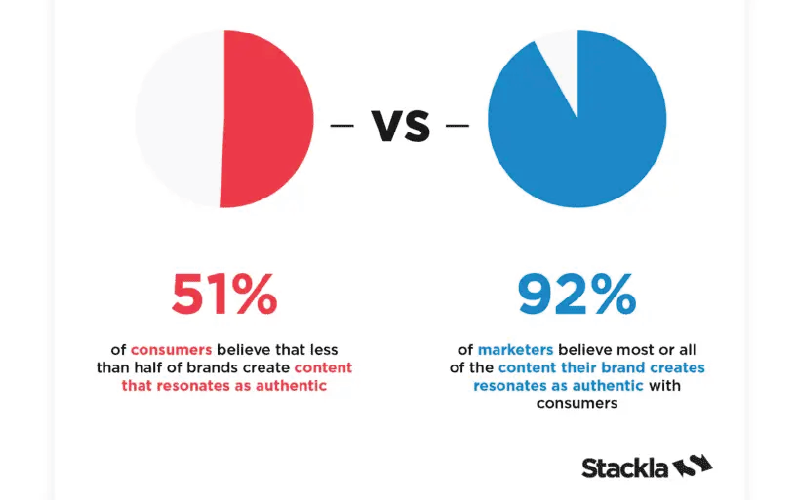
Source: Stackla
Shoppers are 2.4 times more likely to perceive user-generated content as authentic compared to brand-created content.
Ads based on user-generated content achieve click-through rates that are 4 times higher than the average.
When making purchasing decisions, 85% of consumers favour visual UGC over branded content.
Beyond its efficacy, user-generated content also proves to be cost-effective. Studies indicate that ads incorporating UGC experience a 50% decrease.
In terms of influence, the same study reveals that 56% prefer customer-written reviews, 38% favour photo/video content, and 30% respond most to written reviews posted by social media influencers.
User-generated content not only proves to be effective but can also result in cost savings in advertising.
According to a study from Bazaarvoice, ads incorporating user-generated content demonstrate a significant 50% decrease in cost-per-click compared to those that do not.
When considering the most influential types of user-generated content, the same study reveals that 56% of individuals prefer customer-written reviews, 38% lean towards photo/video content, and 30% are most responsive to written reviews posted by social media influencers.
11. Humorous, Trendy, and Relatable Content to Dominate in 2024
The era of prioritizing aesthetics on social media has given way to a shift in consumer preferences.
Based on a survey, a significant 68% of consumers now prioritize authentic and relatable social media content over polished, high-quality visuals.
In terms of memorability, 50% of consumers rank funny content the highest, closely followed by relatable content at 36%. However, when it comes to return on investment (ROI), relatable and trendy content share the top spot.
Interestingly, despite this, a majority of social media marketers, accounting for 66%, still consider funny content to be the most effective format.
Reports suggest that funny content was expected to be the second-highest investment among various content types in 2023. This trend is substantiated by the fact that half of those already utilizing funny content on social media have plans to increase their investment.
Notably, internet memes have emerged as an effective tool for companies to acknowledge customer frustrations, presenting their products as solutions without adopting an overly serious tone. A study from New York University (NYU) reveals that memes boast a 60% higher engagement rate than regular graphics
12. Diversity, Equity, and Inclusion (DEI) Marketing Takes the Spotlight
In the realm of online advertising, a substantial 71% of consumers express the expectation for brands to actively promote diversity and inclusion. However, a significant 54% also feel that they need to be more culturally represented in online ads, according to a study by Facebook.
To tap into the burgeoning market of socially conscious consumers, brands are increasingly adopting Diversity, Equity, and Inclusion marketing techniques.
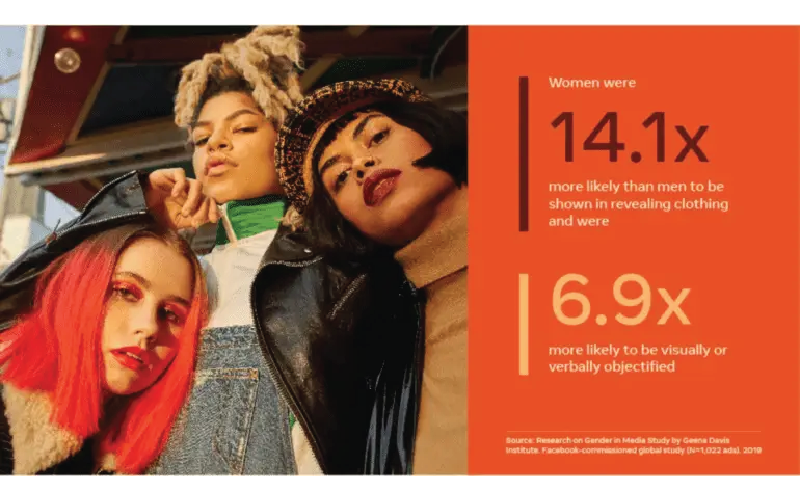
Source: Facebook
This shift implies that businesses can no longer afford to remain silent on pressing social issues such as racial injustice, and the gender pay gap.
Pioneering companies like ThirdLove, Nike, and Bumble are leading the charge in the “inclusive revolution,” crafting innovative campaigns that feature diverse individuals across races, body types, ages, and sexual orientations.
As consumer demand for diversity and inclusivity continues to rise, we anticipate more brands to follow suit, making DEI marketing a central focus in their advertising strategies.
13. Mobile Advertising Trends
Without a doubt, mobile devices have become an integral part of our daily lives, and their impact on advertising is undeniable. As a vast majority of internet users access the web through their smartphones, businesses cannot afford to overlook the significance of mobile advertising. Here’s why:
Sustained Emphasis on Mobile Optimization by Brands
The prevalence of mobile devices, including tablets, contributes to over half of the total yearly internet traffic, underlining the increasing reliance on mobile access among consumers.
To effectively reach a broader audience, businesses are consistently seeking impactful strategies. While Millennials constitute the largest consumer group and Baby Boomers wield significant purchasing power, the spending power of Gen Z is rapidly growing and demands attention.
As per a Bloomberg report, the younger generation and working professionals boast a disposable income of $360 billion. Recognizing this escalating figure, businesses must prioritize mobile-optimized digital experiences to effectively target this dynamic and highly connected demographic.
Additional advertising statistics underscore the critical importance of mobile optimization:
Mobile web design is a priority for 33% of marketers globally.
A significant 64% of SEO marketers consider mobile optimization to be effective.
In the realm of email marketing, 56% prioritize delivering mobile-friendly email experiences to subscribers.
14. Capitalizing on the Mobile Gaming Boom in Advertising
The global in-game advertising market is poised to generate a substantial $13,989.6 million in revenue by 2028, experiencing rapid growth at a noteworthy CAGR of 11.2% over the forecast period from 2021 to 2028. A recent survey by Admix provides insights into emerging advertising trends in this space:
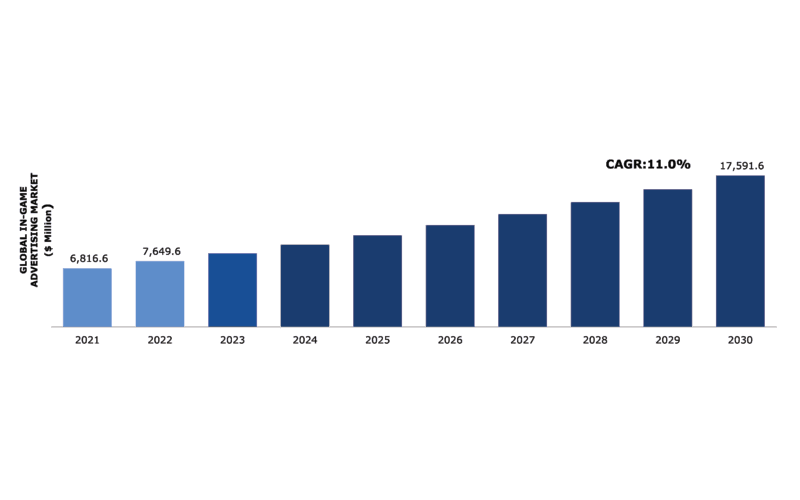
Source: Research Dive
A remarkable 93% of media buyers plan to incorporate in-game advertising into their strategies by 2025. Additionally, 81% intend to maintain or increase in-game advertising spending in the next 12 months, with 83% aiming to fully embrace this format by 2025.
In the U.S., only 33% of media buyer clients currently request in-game activity, while 52% of U.K. clients express interest in this advertising option.
Despite advertisers acknowledging its potential, there is a recognized need for more knowledge on effectively implementing in-game advertising.
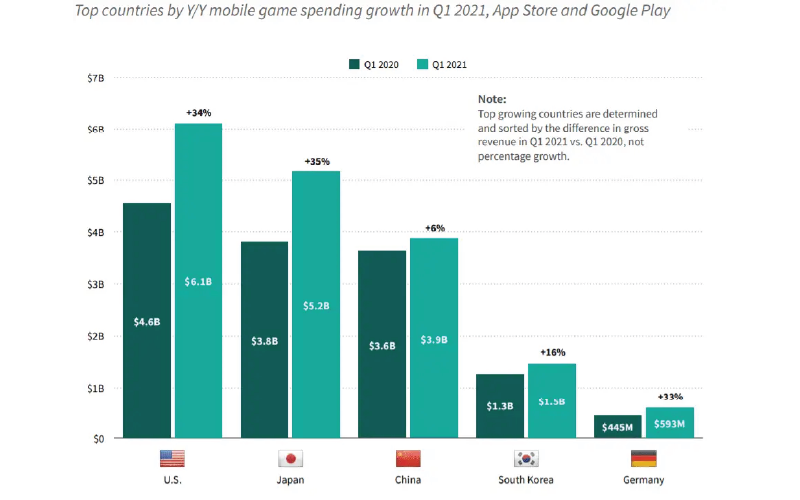
Source: Game World Observer
Leading corporations like Unilever, Coca-Cola, and Ford are already making significant investments in in-game ads. Companies such as Red Bull and Intel have been early adopters of gaming advertising, frequently sponsoring eSports gaming events.
Technology Trends in Advertising
Two of the most widely discussed technological trends in advertising are ChatGPT and the Metaverse, but their longevity remains a question. Let’s explore how these technologies are reshaping the advertising landscape:
15. AI Takes Center Stage in Advertising
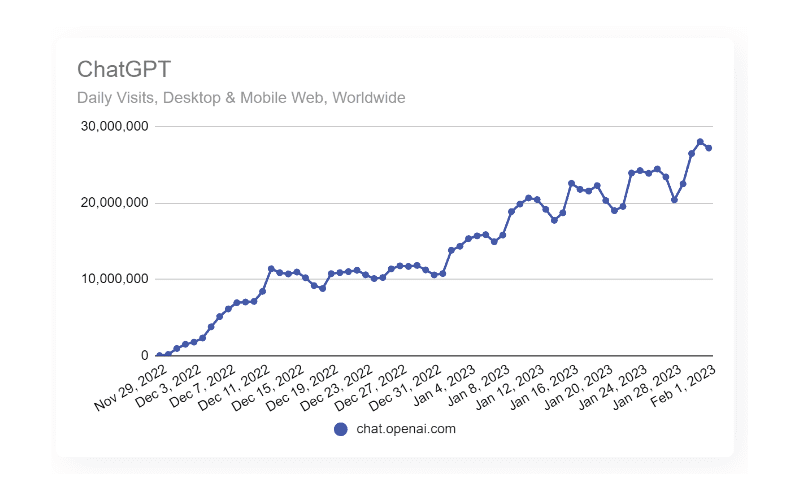
Source: Similar Web
The growing prominence of AI in marketing raises questions about consumer perceptions. A significant 62% of consumers express comfort with generative AI in marketing and advertising, as long as it does not adversely affect their overall experience.
Moreover, a substantial 64% of consumers are open to purchasing products recommended by AI
Undoubtedly, the trends in AI adoption for advertising are on the rise.
According to Gartner’s predictions, by 2025, approximately 30% of outgoing marketing messages from large corporations will be AI-generated, indicating the increasing integration of AI in shaping advertising strategies.
16. Increasing Brand Investments in the Metaverse for Advertising
In the words of Mark Zuckerberg, the Metaverse is not merely something a company builds but represents the next chapter of the internet as a whole.
Forbes identifies the Metaverse as one of the top 10 trends to watch in 2023, and this momentum is expected to continue into 2024. The foundational technology of the Metaverse, virtual and augmented reality (VR/AR), is projected to witness substantial growth, with spending expected to surge from $12 billion in 2020 to $72.8 billion by 2024

Source: Statista
This significant expansion has led leaders across various industries, including gaming, retail, arts, healthcare, blockchain, and more recently, advertising, to position themselves as key players in this emerging ecosystem.
Statista data indicates that ad spending in the metaverse advertising industry is anticipated to reach $2.52 billion by 2030, underscoring the increasing focus and investments in advertising within the Metaverse.
17. Diversifying Content Across Platforms Is Key in 2024
A Hubspot survey has highlighted that social media marketers, on average, manage four platforms. While cross-posting has been a common practice, many marketers are now steering away from a one-size-fits-all approach.
Although 17% of marketers continue to cross-post identical content, the prevailing trend is shifting away from mere copy-pasting. Nearly half, or 48%, of marketers are actively modifying their content when sharing it on different platforms. Additionally, over a third, constituting 34%, are opting to create unique content from scratch for each platform.
18. Advertisers Gear Up for the Phasing Out of Third-Party Cookies
In a significant move, Google announced in May 2023 its intention to gradually phase out support for third-party cookies due to mounting privacy concerns.
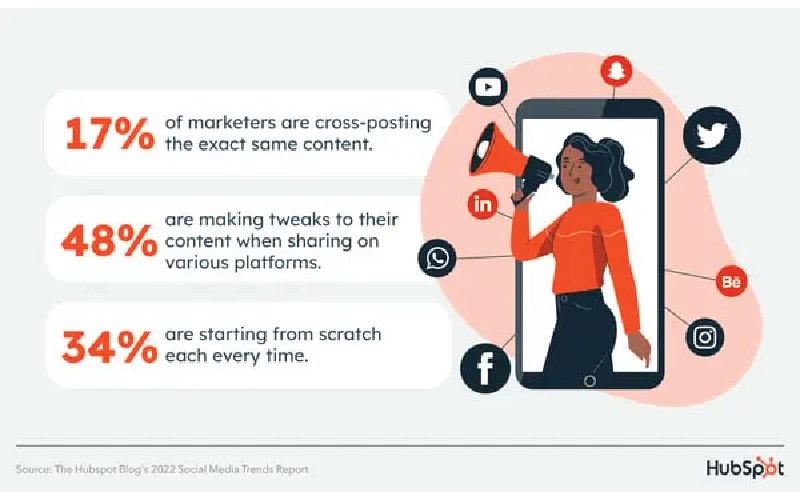
Source: Hubspot
The phased-out process is slated to commence midway through 2024.
Third-party cookies have played a crucial role in targeted marketing, enabling the tracking of user behavior across the web for the delivery of personalized experiences. Since Google’s announcement, brands have been actively exploring alternative targeting solutions to stay relevant and craft highly customized content and ads.
Personalization Trends in Advertising
Empowered by extensive data, brands can now craft highly targeted and personalized advertisements for their audience. This enduring trend is driven by consumer expectations for more personalized experiences while simultaneously valuing privacy protection.
19. The Rise of Signal-Based Advertising According to Marketers
Signal-based marketing, a strategy that leverages consumer events and behaviours to deliver personalized messages without relying on third-party cookies, is gaining traction.
These events, referred to as signals, occur at specific times and can reveal consumer interests and affinities.
Signal-based advertising has demonstrated its effectiveness, as evidenced by Amazon’s implementation of this approach through its new Amazon DSP feature. This self-service solution enables marketers to purchase non-cookie-based, intent-driven ads.
Neal Richter, the Director of Bidding Science and Engineering at Amazon Ads, highlighted the advantages of signal-based marketing in a recent statement:
Cookies are false precision. Signal-based marketing, by contrast, allows brands using Amazon DSP to engage consumers with relevant, useful advertising, as opposed to repeatedly showing them an ad for a product they had considered and not purchased.
By harnessing machine-learning models and utilizing Amazon’s extensive data signals, signal-based marketing empowers brands to strategically place ads in the most relevant locations at the right time, focusing on the current context rather than relying on historical patterns.
Brands adopting Amazon DSP have reported a notable 20% to 30% increase in their ability to reach target audiences on browsers like Safari and Firefox, as well as on operating systems such as the iPhone operating system (iOS).
20. The Surge of Branded Social Media DM Strategies
Utilizing direct messaging (DM) on social media platforms for customer service is a relatively recent practice, but it has already been embraced by 29% of marketers. A Hubspot survey reveals that one in five Gen Zers and nearly 25% of Millennials have reached out to brands on social media seeking customer support.

Source: Hubspot
The trend extends beyond customer support, with brands actively exploring ways to monetize DMs.
Social media engagement is transforming, with a growing emphasis on messaging platforms, prompting applications to prioritize and enhance their direct messaging features. Innovative approaches to monetizing DMs and leveraging messaging platforms for marketing purposes are actively being explored.
Stay Informed About the Latest Advertising Trends
Remaining abreast of the latest trends is crucial for optimizing advertising budgets and effectively reaching target audiences.
To elevate your marketing campaigns, consider partnering with a digital marketing agency like Thrive. Whether it’s social media advertising or Amazon paid ads, we can assist you in navigating the evolving advertising landscape.

